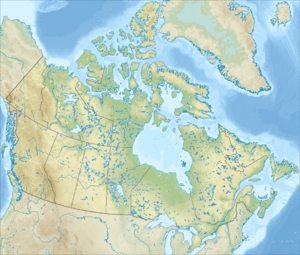Thelon River
| Thelon River (Akilinik) | |
|
An oasis-like section of the Thelon, below Warden's Grove
|
|
| Name origin: "on the other side" in Inuktitut | |
| Country | Canada |
|---|---|
| Province | Northwest Territories, Nunavut |
| Source | Whitefish Lake. |
| - location | Northwest Territories |
| - coordinates | 62°30′32″N 106°49′17″W / 62.50889°N 106.82139°W |
| Mouth | Baker Lake |
| - location | near Chesterfield Inlet, Kivalliq Region, Nunavut |
| - coordinates | 64°16′30″N 96°4′35″W / 64.27500°N 96.07639°WCoordinates: 64°16′30″N 96°4′35″W / 64.27500°N 96.07639°W |
| Length | 900 km (560 mi) |
| Basin | 142,400 km2 (55,000 sq mi) |
The Thelon River (Inuktitut: Akilinik, lit. ‘on the other side’) stretches 900 kilometres (560 mi) across northern Canada. Its source is Whitefish Lake in the Northwest Territories, and it flows east to Baker Lake in Nunavut. The Thelon ultimately drains into Hudson Bay at Chesterfield Inlet.
The drainage basin of the Thelon River encompasses some 142,400 square kilometres (55,000 sq mi). Located far from almost all human development, the Thelon and its surroundings are entirely pristine wilderness. It has been described as Canada's remotest river.
The river has a width of up to a kilometer (0.6 mi) along much of its lower section, widening into Beverly, Aberdeen, and Schultz Lakes about 100 kilometres (62 mi) upstream from its mouth at Baker Lake.
Approximately 100 moose and more than 2,000 muskoxen forage on the land around the Thelon. 300,000 migrating barren-ground caribou cross the river every fall and spring.
The Inuit people, including Caribou Inuit and Copper Inuit, have long occupied the sparsely-populated lands around the Thelon. Artifacts of Inuit hunting and travel (including inukshuk guide stones) are readily observed near the river.
In 1770–71, English explorer Samuel Hearne crossed the Thelon while exploring Canada's northern interior.
Over the winter of 1926–27, Canadian naturalist John Hornby starved to death on the Thelon along with two other men. They had planned to hunt migrating caribou, but failed to find the herd. Nevertheless, on the basis of Hornby's earlier explorations with James Critchell-Bullock in 1923, the Thelon Game Sanctuary was established in 1927, renamed the Thelon Wildlife Sanctuary in 1956.
...
Wikipedia


